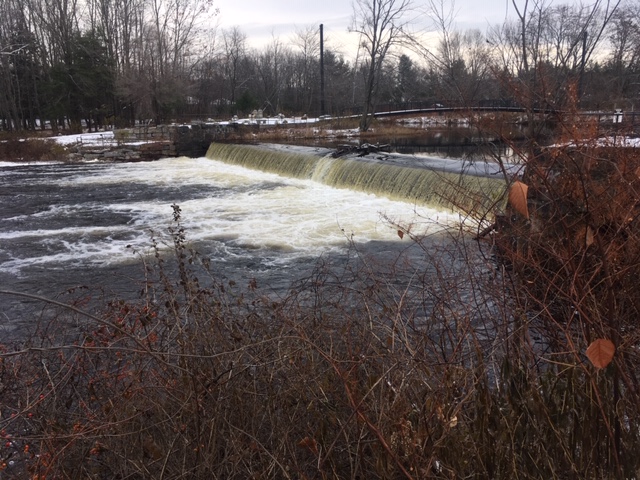By one estimate there as many as two million dams in the United States. They were built for water power, flood control, public water supply or irrigation and in some cases multiple purposes.
This blog posting is about those older dams that are no longer doing their original jobs of providing industrial power. I recently had an awakening about what to do with one of these ancient structures.
The dam in question spans the Ashuelot River as it flows south through Keene, New Hampshire to meet the Connecticut River.
Alternately called the West Street Dam and the Ashuelot River Dam, it provided the source of power for the milling of lumber and the production of textiles in the Faulkner & Colony Mill in Keene beginning in the 19th century.
The dam, made of stone, is 160 feet wide and about 16 feet high. It stopped sending water to turbines long ago. The mill itself was shuttered in 1954, and in the 1980s its handsome brick buildings were repurposed as a shopping mall; the buildings are currently undergoing another repurposing to office and residential condominiums.
Today the dam and the smallish impoundment behind it are surrounded by parkland that resulted from an energetic fund-raising campaign a couple of decades ago. It’s a place for picnics, an annual art festival, gentle hiking and photo shoots for high school proms.
In 2011, citing concerns about the dam’s stability, the New Hampshire state government ordered the city of Keene, which owns the structure, to either fix it up or take it down.
Not long afterwards, a group of local green-leaning citizens proposed to bring hydro back to the dam by installing two turbines. They had a plan: The operation would be mainly educational since the estimated output would be sufficient to serve only about three dozen homes. Eventually the group lost interest.
The city, then, was left with what to do about the dam. Several weeks ago, it organized a public discussion through the services of the Rhode Island School of Design. The Providence-based institution not long ago shared in a $6 million grant from the National Science Foundation to help communities decide what to do with out-of-service dams or dams that were undergoing relicensing as they balanced such concerns as historic preservation, fish passage, safety and renewable energy production
I attended the session in Keene, where I participated in a small-group discussion around a table.
At the outset, when asked about my preference and priorities, I unhesitatingly said “historic preservation.” The dam, I said, represented a daily visual reminder of our water-powered industrial heritage, and therefore should be restored and kept in place
Forty-five minutes later, following an illustrated presentation about various options that included demolition, restoration and provisions for fish passage, I was asked again about my preference. I replied, to my surprise: take the thing down.
The difference resulted from several reflections, including but not limited to:
(1) Restoration and continued maintenance of the dam could involve serious taxpayer money forever;
(2) Humans have an historical claim on the river, but fish have an earlier claim that, if the dam were to remain standing, would involve the construction of expensive fish passage structures that one way or the other would deface the dam or render it invisible;
(3) Demolition of the span of the dam could leave visual mementos in substantial parts of the bulwarks on both sides of the river;
(4) Public education about the dam and its place in local history could possibly be conveyed in new ways that incorporate new methods and approaches.
It might well be that the city of Keene ultimately settles on a decision that’s different from mine. I won’t complain. Over the years this community has shown a remarkable sensitivity to environmental and historical matters; its decisions commonly reflect a lot of thought.
That inclination is infectious. I’m now thinking freshly about how we remember and honor our history, all the way down to what’s happened in a river over the years. What would you do?
